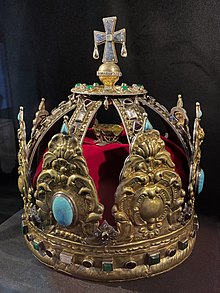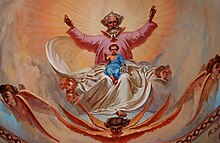Culture of Georgia (country)
| Part of a series on the |
| Culture of Georgia (country) |
|---|
 |
| History |
|
People |
|
Languages |
| Mythology |
| Cuisine |
| Festivals |
| Religion |
| Art |
|
Literature |
| Music |
| Sport |
This article needs additional citations for verification. (March 2020) |
The culture of
Culture of Ancient and Old Georgia

The
Georgia's
Ecclesiastical art

Medieval Georgian icons are renowned as being among the finest creations of Orthodox religious art. Notable examples include:
- The Icon of 886 from Zarzma monastery
- The Icon of the 9th century from Tsilkani
- The famous Wonderworking Iberian Icon of the Mother of God(10th century)
- The Icon of the 10th century from Okona
- The Icon of Our Lady of Khakhuli of the 12th century
- The Icon of St. George of the 11th century from Labechina
- The Icon of St. George of the 11th century from Nakipari
- The Anchiskhati
- The Icon of the 14th century from Ubisa
- The Icon of the 16th century from Alaverdi
Ecclesiastical monuments


Well-known monuments of Georgian Christian architecture include:
- The Georgian Church in Bethlehem (4th century)
- The Church of region)
- Akaurta Church (5th century) in Bolnisi district (Kvemo Kartli region)
- Ikalto Monastery complex (5th-7th centuries) (Kakheti)
- Sioni Church (5th century) in Bolnisi
- Monastery of Shio Mghvime(6th century)
- DavidgarejaMonastery complex (6th-7th centuries)
- Jvari Monastery in Mtskheta(6th century)
- Anchiskhati Church (6th century) in Tbilisi
- Nekresi Monastery Complex (4th-9th centuries) in Kakheti
- Sioni church (7th century) in Ateni
- Petritsoni Monastery in Bulgaria (11th century)
- The Georgian Monastery (10th century) on the Black Mountain in Syria (now territory of Turkey)
- The Georgian Iveron Monastery on Athos(10th century)
- Svetitskhoveli Cathedral in Mtskheta (11th century)
- Opiza Monastery (10th century) in Tao-Klarjeti (now territory of Turkey)
- Monastery Doliskana (10th century) in Tao-Klarjeti (now territory of Turkey)
- Monastery Otkhta-Eklesia in Tao-Klarjeti (now territory of Turkey)
- Oshki Monastery (10th century) in Tao-Klarjeti (now territory of Turkey)
- Bagrati Cathedral (11th century) in Kutaisi
- Gelati Monastery (11th century) in Kutaisi
- Motsameta monastery (11th century) in Imereti
- Sioni Cathedral (11th century) in Tbilisi
- Alaverdi church (11th century) in Kakheti
- Monastery Samtavro (12th century) in Mtskheta
- Vardzia Monastery (12th century) in Meskheti
- Gialia Monastery (10th-16th centuries) in Cyprus
Well-known Georgian painters were Damiane (13th century), Anania (15th century), Mamuka Tavakarashvili (17th century), etc.
The works of the famous Georgian goldsmiths, Beka and Beshken Opizari (11th century), are outstanding contributions to world art.
Literary and other written works
Important Georgian literary works of the pre-Christian period are:
- Amiraniani, ancient Georgian folk epos (see also: Amiran-Darejaniani and Amirani).
Notable Georgian written works from the medieval period include:
- Martyrdom of the Holy Queen Shushanik by Iakob Tsurtaveli (the oldest surviving work of the Georgian literature written between 476 and 483)
- Corpus Areopagiticum, a philosophical and theological work attributed by some to Peter the Iberian(5th century)
- The Life of Saint Nino (8th century) (anon)[1]
- Ioane Sabanisdze(8th century)
- The Life of Grigol Khandzteli by Giorgi Merchule (10th century)
- A History of the Georgian Kings ("Tskhovreba Kartvelta Mepeta") by Leonti Mroveli (11th century)
- Sumbat Davitisdze(11th century)
- Eteriani, a folk epic (c. 11th century)
- Life of the King Farnavaz (anon) (11th century)
- Ustsoro Karabadini (Peerless Karabadini) (11th century)[2]
- Tamariani by Ioane Chakhrukhadze (12th century)
- Bagrationi(12th century)
- Vepkhistkaosani (epic poem by Shota Rustaveli(12th century)
- Abdulmesiani by Ioane Shavteli(13th century)
- Kartlis Tskhovreba(History of Georgia), a collection of old Georgian chronicles (from ancient times to the 14th century)
Culture of Georgia today

Starting from the early 16th century,
During the modern period, from about the 17th century onwards, Georgian culture has been greatly influenced by cultural innovations imported from elsewhere in Europe.[citation needed][dubious ]
The first Georgian-language printing house was established in the 1620s in Italy, and the first one in Georgia itself was founded in 1709 in Tbilisi.
Georgian theatre has a long history; its oldest national form was the "Sakhioba" (extant from the 3rd century BC to the 17th century AD). The Georgian National Theatre was founded in 1791 in Tbilisi, by the writer, dramatist, and diplomat Giorgi Avalishvili (1769–1850). Its leading actors were Dimitri Aleksi-Meskhishvili, David Machabeli, David Bagrationi, Dimitri Cholokashvili, and others.

In Tbilisi, the
Greatest representatives of Georgian culture of the 19th century were:
The first cinema in Georgia was established in Tbilisi on November 16, 1896. The first Georgian cinema documentary ("Journey of Akaki Tsereteli in Racha-Lechkhumi") was shot in 1912 by Vasil Amashukeli (1886–1977), while the first Georgian feature film ("Kristine") was shot in 1916 by Alexandre Tsutsunava (1881–1955).
The Tbilisi State Academy of Arts was founded in 1917.
Georgian culture suffered under the rule of the Soviet Union during the 20th century, during which a policy of Russification was imposed but was strongly resisted by many Georgians. Since the independence of Georgia in 1991, a cultural resurgence has taken place, albeit somewhat hampered by the country's economic and political difficulties in the post-Soviet era.
Cuisine
Georgian cuisine is the result of the broad interplay of culinary ideas carried along the Silk Road Trade route by merchants and travelers alike.[7] The importance of both food and drink to Georgian culture is best observed during a feast called supra, when a huge assortment of dishes are prepared, always accompanied by large amounts of local wine, known to be one of the world's oldest wines, produced in ancient authentic Georgian underground kvevri clay pots (dating 8 century BC). In a Georgian feast, the role of the tamada (toastmaster) is an important and honoured position.
Famous Georgian cultural figures
Some famous Georgian cultural figures from the 20th–21st centuries are:
Actors
- David "Dodo" Abashidze
- Veriko Anjaparidze
- Spartak Bagashvili
- Givi Berikashvili
- Ramaz Chkhikvadze
- Kakhi Kavsadze
- Ipolite Khvichia
- Akaki Khorava
- Zurab Kipshidze
- Avtandil Makharadze
- Merab Ninidze
- Guram Sagaradze
- Karlo Sakandelidze
- Sesilia Takaishvili
- Bukhuti Zakariadze
- Sergo Zakariadze
- Nato Vachnadze
- Sofiko Chiaureli
Ballet dancers


- Nino Ananiashvili
- Vakhtang Chabukiani
- Irma Nioradze
Composers
- Sulkhan Tsintsadze
- Dimitri Arakishvili
- Andria Balanchivadze
- Meliton Balanchivadze
- Alexandre Basilaia
- Gia Kancheli
- Bidzina Kvernadze
- Giorgi Latsabidze
- Zakharia Paliashvili
- Otar Taktakishvili
Filmmakers
Opera singers
Painters

Pianists
Poets

- Shota Rustaveli
- Galaktion Tabidze
- Alexander Abasheli
- Irakli Abashidze
- Rati Amaglobeli
- Diana Anphimiadi
- Lado Asatiani
- Valerian Gaprindashvili
- Terenti Graneli
- Ioseb Grishashvili
- Paolo Iashvili
- Ana Kalandadze
- Giorgi Leonidze
- Mukhran Machavariani
- David Magradze
- Kolau Nadiradze
- Vazha-Pshavela
- Titsian Tabidze
- Nikoloz Baratashvili
- Ilia Chavchavadze
- Akaki Tsereteli
- Bela Chekurishvili
Sculptors
Theatre producers
Writers, male
- Vasil Barnovi
- Lasha Bugadze
- Otar Chiladze
- Tamaz Chiladze
- Konstantine Gamsakhurdia
- Levan Gotua
- Shalva Dadiani
- Guram Dochanashvili
- Mikheil Javakhishvili
- Otia Ioseliani
- Jemal Karchkhadze
- Leo Kiacheli
- David Kldiashvili
- Aka Morchiladze
- George Papashvily
- Guram Rcheulishvili
- Grigol Robakidze
- Avksenty Tsagareli
- David Turashvili
- Nodar Dumbadze
- Terenti Graneli
- Boygar Razikashvili
Cultural groups
Dance troupes
- Erisioni
- Sukhishvilebi - Georgian National Ballet
Choirs
- Rustavi Choir
Sport
- Zaza Pachulia (basketball player for Golden State Warriors)
- Kakha Kaladze (footballer for AC Milan)
- Khvicha Kvaratskhelia (footballer for SSC Napoli)
Rugby union is a popular team sport played in Georgia. Rugby union is considered the second most popular sport in Georgia, after football.
See also
- Outline of culture
- Outline of Georgia (country)
- History of Georgia
- Georgian people
- Georgian language
- Georgian Orthodox and Apostolic Church
- Music of Georgia
- Dances of Georgia
- Keipi
- Kinto
- Architecture of Georgia
- List of museums in Georgia (country)
References
- ^ Baramidze, Georgian literature
- ^ Destin de la Géorgie, Issues 36-37, 1978, p. 277
- ^ ISBN 1850439303p 494
- ^ Betz, Hans Dieter (2008). Religion past and present. Brill (originally from the University of Michigan. p. 361.
(...) Since the 12th century and under Persian cultural influence, secular literature also developed (in Georgia)
- ^ Kennan, Hans Dieter; et al. (2013). Vagabond Life: The Caucasus Journals of George Kennan. University of Washington Press. p. 32.
(...) Iranian power and cultural influence dominated eastern Georgia until the coming of the Russians
- ^ Chardin, Jean (1686). The travels of Sir John Chardin into Persia and the East Indies.
- ^ Food Cultures of the World Encyclopedia, Volume 1, Ken Albala, p. 125
- ^ Chkheidze, Levan. "Georgian Art Portal | Artists". Art.Gov.Ge (in English and Georgian). Didistudia llc. Archived from the original on 17 November 2011. Retrieved 11 October 2020.
Further reading
- Enzyklopädie des Märchens Online, edited by Rolf Wilhelm Brednich, Heidrun Alzheimer, Hermann Bausinger, Wolfgang Brückner, Daniel Drascek, Helge Gerndt, Ines Köhler-Zülch, Klaus Roth and Hans-Jörg Uther. Berlin, Boston: De Gruyter, 2016 [1987]. https://www-degruyter-com.wikipedialibrary.idm.oclc.org/database/EMO/entry/emo.5.156/html. Accessed 2023-07-02.
- Gogiashvili, Elene (2011). "ზებუნებრივ არსებასთან ქორწინების უძველესი მოდელი ზღაპარში" [Archaic Motifs of Marriage with a Supernatural Being in Folktales]. სჯანი (in Georgian) (12): 209–217.
- Kʻurdovaniże, Tʻeimuraz et al. The index of Georgian folktale plot types: systematic directory, according to the system of Aarne-Thompson. Tbilisi: Merani, 2000.
External links
- Georgia History and Culture (in German)
- Georgian Web by Besiki Sisauri
- Friends of Georgia International Foundation Archived 2004-03-21 at the Wayback Machine Information on Georgian Culture & History
- Georgian eBooks Many online Georgian e-books (PDF) on the CD "Anthology of Georgian classical literature" by UNESCO Project
- Authors
- Georgian Art, Tiflis Avenue
- TITUS projects Armazi and Ecling
- Georgia - South Caucasus (in German and English)
- From the Cradle of Wine
- Kharbedia, Malkhaz: "Conformism and Resistance: The Birth of the Modern Georgian Literature" in the Caucasus Analytical Digest No. 14
- Georgian Contemporary Art Portal (in English and Georgian)
- Web Platform of Comparative Folk Narrative Research, with record of Georgian folktales classified according to the ATU index
